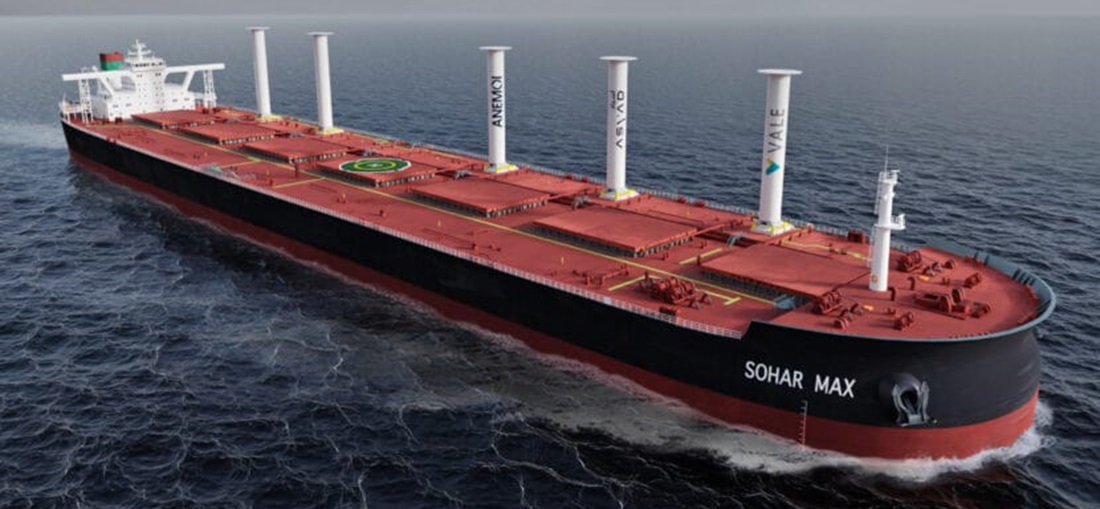
How Vale Plans to Use Wind Energy to Power Its Giant Iron Ore Ships
Dec, 19, 2024 Posted by Denise VileraWeek 202448
Vale is conducting the world’s largest test of a ship with rotating sails on its iron ore carrier Sohar Max. This Valemax giant, 362 meters long with a capacity to carry 400,000 tons, departed for Malaysia last Friday, the 13th, with its seven compartments filled with iron ore loaded at the Tubarão Port in Espírito Santo.
On this ship, five rotating sails were installed—cylindrical towers aligned along the deck that can spin in both directions at high speeds. They assist in propelling the vessel, providing auxiliary power to the main engine, which is still powered by fossil fuels. When in operation, the sails increase the relative wind speed as the ship moves, creating a pressure differential that accelerates the vessel; this is known as the “Magnus effect,” the same principle that explains the extra acceleration of a soccer ball when kicked with spin.
Results
In laboratory tests, wind power was expected to reduce fuel consumption by up to 6% and annual CO₂ equivalent emissions by up to 3,000 tons per ship.
However, Vale’s Navigation Director, Rodrigo Bermelho, told Estadão/Broadcast that on the Sohar Max’s maiden voyage from China to Brazil, with this technology onboard, marine fuel (bunker) savings reached 9%, which already includes the energy consumption required to rotate the sails.
“There were some strong winds, up to 18 knots (29 km/h). Generally, the crews don’t like that, but they were happy to test the sails. We managed to increase speed by 1.5 knots (2.7 km/h). But the priority is not speed; it’s reducing fuel consumption,” Bermelho explained.
Investment and Goals
The ship in question is not owned by Vale but by the Omani shipping company Asyad. It is in the 13th year of a 25-year charter agreement. Still, the mining company funds the tests and monitoring of the rotating sails, which are at the frontier of this technology. The adaptation of this ship alone cost US$13 million (R$78 million).
A smaller vessel of the Guaibamax type had already received the technology in 2021 at a cost of US$9 million (R$54 million). The Finnish company Norsepower manufactured these first sails. As part of its Ecoshipping research and development project, Vale has five other similar projects planned for the coming years, including one involving rigid sails, a distinct technology. The initiative is six years old, with the latest pilot on the Sohar Max being two years old.
According to Bermelho, costs are declining as technology advances, and Vale aims to equip its fleet with these devices and provide shipowners with results so they can take the lead in the process in the future. Vale has nearly 200 chartered ships, and the aim is for at least 40% of them to have wind propulsion in the coming years, in line with the International Maritime Organization’s (IMO) goal to achieve net-zero emissions in the sector by 2050.
“Wind has been part of navigation for centuries, and we are reconnecting with that now, but in a different way. It’s possible that in the future, we may need to adjust our ships’ routes to capture more wind,” said Vale’s Navigation Director.
Other projects in Vale’s Navigation sector with the same purpose include using silicone paint to reduce resistance, installing frequency inverters to reduce electrical consumption, and using hydrodynamic devices to improve propulsion.
Source: O Estado de S. Paulo
-
Trade Regulations
May, 29, 2024
0
Peru opens market for Brazilian bovine and swine blood products
-
Ports and Terminals
Mar, 18, 2022
0
The Port of Santos’ net profit grows 63% to R$ 329 million in 2021
-
Trade Regulations
Aug, 19, 2020
0
Secex eliminates need for import licences on 210 products
-
Jan, 30, 2023
0
Chile ranks among world’s largest fruit exporters in 2022

